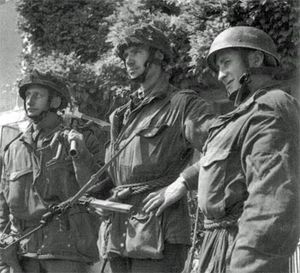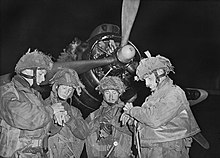6th Airborne Division (United Kingdom)
| 6th British Airborne Division | |
|---|---|
 Glider infantry of D Company, 2nd Battalion, Oxfordshire and Buckinghamshire Light Infantry, of the 6th Airlanding Brigade, 6th Airborne Division, in Normandy 1944. | |
| Active | 1943–1948 |
| Country | |
| Branch | |
| Type | Paratrooper |
| Role | Airborne forces Raiding Reconnaissance |
| Size | Division |
| Nickname(s) | Red Devils [nb 1] |
| Motto(s) | Go To It[2] |
| Engagements | World War II Capture of the Caen canal and Orne river bridges Operation Tonga Battle of Merville Gun Battery Operation Mallard Battle of Bréville Advance to the River Seine Battle of the Bulge Operation Varsity Palestine Emergency |
| Commanders | |
| Notable commanders | Sir Richard Gale Sir James Cassels Sir Hugh Stockwell |
| Insignia | |
| Emblem of the British airborne forces |  |
The 6th Airborne Division was an
The division's initial operation, which also resulted in it becoming the first
After the war the division was identified as the Imperial Strategic Reserve, and moved to the Middle East. Initially sent to Palestine for parachute training, the division became involved in an internal security role. In Palestine, the division went through several changes in formation, and had been reduced in size to only two parachute brigades by the time it was disbanded in 1948.
Creation
On 31 May 1941, a joint
This second formation was numbered the 6th Airborne Division, and commanded by
From June to December 1943, the division prepared for operations, training at every level from
At the end of the war in Europe, in May 1945, the division was selected to go to India and form an airborne corps with the 44th Indian Airborne Division.[15] The division’s advance party, formed around the 5th Parachute Brigade, had already arrived in India, when the Japanese surrendered after the Atomic bombings of Hiroshima and Nagasaki.[16] Following the surrender, all these plans changed. The post-war British Army only needed one airborne division, and the 6th Airborne was chosen to remain on strength and was sent to the Middle East as the Imperial Strategic Reserve.[17]
When the division was dispatched to the Middle East, the 2nd Parachute Brigade was assigned to bring them up to strength.[18] In May 1946, after the 1st Airborne Division was disbanded, the 1st Parachute Brigade joined the division, replacing the 6th Airlanding Brigade.[19] The next major manpower development came in 1947, when the 3rd Parachute Brigade was disbanded and the 2nd Parachute Brigade, while remaining part of the division, was withdrawn to England, then sent to Germany.[20] On 18 February 1947, it was announced that the 6th Airborne Division would be disbanded when they left Palestine.[21] Gradually the division's units left the country and were disbanded, the last ones comprising part of divisional headquarters, the 1st Parachute Battalion and the 1st Airborne Squadron, Royal Engineers, departed on 18 May 1948.[21]
Operational history

On 23 December 1943, the division was told to be prepared for active service from 1 February 1944.
D-Day

The

Shortly afterwards the aircraft carrying Brigadier Nigel Poett's 5th Parachute Brigade arrived overhead heading for their drop zone (DZ) to the north of Ranville. The brigade were to reinforce the defenders at the bridges, the 7th Parachute Battalion in the west, while the 12th Parachute Battalion and the 13th Parachute Battalion dug in to the east, centred around Ranville, where brigade HQ would be located.
Brigadier
Normandy
Breakout

With the capture of Breville the division was not attacked in force again, apart from an almost continuous artillery bombardment between 18 and 20 June.
Ardennes
In England the division went into a period of recruitment and training, concentrating on house to house street fighting in the bombed areas of
Rhine crossing

Whereas all other Allied airborne landings had been a surprise for the Germans, the Rhine crossing was expected, and their defences were reinforced in anticipation. The airborne operation was preceded by a two-day round-the-clock bombing mission by the Allied air forces. Then on 23 March 3,500 artillery guns targeted the German positions. At dusk
Far East
The 5th Parachute Brigade was sent to the Far East arriving after VJ Day, they were sent to protect and secure Dutch East Indies interest and property, as well as dealing with internal security in Java and Singapore, whilst disarming members of the Japanese Army till 1946. By this time they were sent back to Palestine to take part in peacekeeping with the rest of the 6th Airborne Division.
Palestine

In late 1945, the 6th Airborne Division deployed to
Order of battle
The 6th Airborne Division was constituted as follows during the war:[40]
6th Airlanding Brigade (from 6 May 1943)
- 2nd Battalion, Oxfordshire and Buckinghamshire Light Infantry
- 1st Battalion, Royal Ulster Rifles
- 12th Battalion, Devonshire Regiment
3rd Parachute Brigade (from 15 May 1943)
- 7th (Light Infantry) Parachute Battalion (left 11 August 1943)
- 8th (Midlands) Parachute Battalion
- 9th (Eastern and Home Counties) Parachute Battalion
- 1st Canadian Parachute Battalion (from 11 August 1943)
5th Parachute Brigade (from 1 June 1943, left 19 July 1945)
- 12th (Yorkshire) Parachute Battalion
- 13th (Lancashire) Parachute Battalion
- 7th (Light Infantry) Parachute Battalion (from 11 August 1943)
2nd Independent Parachute Brigade Group (from 29 August 1945)
Divisional Troops
- 22nd Independent Parachute Company, Army Air Corps (from 26 October 1943, left 19 July 1945)
- 1st Airborne Light Tank Squadron, Royal Armoured Corps (left 13 January 1944)
- 6th Airborne Armoured Reconnaissance Regiment (from 14 January 1944)
- 3rd Airlanding Anti-Tank Battery, Royal Artillery - 6-pdr and 17-pdr anti-tank guns
- 4th Airlanding Anti-Tank Battery, Royal Artillery - 6-pdr and later 17pdr anti-tank guns [41]
- 53rd (Worcester Yeomanry) Airlanding Light Regiment, Royal Artillery 3 November 1943)
- 2nd Airlanding Light Regiment, Royal Artillery (from 24 February 1945)
- 2nd Airlanding Light Anti-Aircraft Battery, Royal Artillery (from 26 May 1943, left 20 February 1944)
- 249th (East Anglian) Field Company (Airborne), Royal Engineers (from 7 June 1943)
- 3rd Parachute Squadron, Royal Engineers (from 7 June 1943, became 3rd Airborne Squadron, Royal Engineers 28 May 1945)
- 591st (Antrim) Parachute Squadron, Royal Engineers(from 7 June 1943, left 28 May 1945)
- 9th Airborne Squadron, Royal Engineers (from 1 June 1945)
- 286th (Airborne) Field Park Company, Royal Engineers (from 7 June 1943)
- 6th Airborne Divisional Signals Regiment, Royal Corps of Signals (from 7 May 1943)
Units attached
- 1st Special Service Brigade
- 4th Special Service Brigade
- 1st Belgian Infantry Brigade
- Royal Netherlands Motorized Infantry Brigade
Commanders
- Major-General Richard Gale(1943 - 1944)
- Major General Eric Bols (1944 - 1946)
- Major-General James Cassels (1946)
- Major General Eric Bols (1 January 1947)[42]
- Major-General Hugh Stockwell (1947 - 1948)
See also
Notes
- Footnotes
- ^ The 1st Parachute Brigade had been called the "Rote Teufel" or "Red Devils" by the German troops they had fought in North Africa. The title was officially confirmed by General Sir Harold Alexander and henceforth applied to all British airborne troops.[1]
- 5th Airborne Division were deception divisions.[7]
- Citations
- ^ Otway, p.88
- ^ Saunders, p.189
- ^ "The 6th Airborne Division in Normandy". www.pegasusarchive.org. Retrieved 22 February 2016.
- ^ Tugwell, p.123
- ^ a b Harclerode, p.223
- ^ Tugwell, p.202
- ^ Holt, pp.617, 827 and 915
- ^ Guard, p.37
- ^ "The British Airborne Assault". Ministry of Defence (United Kingdom). Archived from the original on 30 January 2006. Retrieved 26 November 2011.
- ^ Tugwell, p.209
- ^ Ford, pp.19–20
- ^ Historic England. "Syrencot House (1183033)". National Heritage List for England. Retrieved 17 September 2016.
- ^ a b Harclerode, p.225
- ^ a b c Guard, p.225
- ^ Gregory, p.125
- ^ Wilson, p.3
- ^ Wilson, p.4
- ^ Wilson, pp.212–213
- ^ Wilson, pp.214–215
- ^ Wilson, pp.216–217
- ^ a b Cole, p.209
- ^ Harclerode, p.226
- ^ Gregory 1979, p.100
- ^ Saunders 1971, p.143
- ^ Gregory 1979, p.101
- ^ Arthur, Max (11 May 1999). "Obituary, Major John Howard". The Independent. Archived from the original on 17 March 2011. Retrieved 1 April 2010.
- ^ Cole 1963, p.93
- ^ Harclerode, p.348
- ^ Otway 1990, pp.187–188
- ^ Saunders 1971, p.196
- ^ a b Saunders, p.279
- ^ Gregory, p.118
- ^ Hastings, p.239
- ^ a b Harclerode, p.549
- ^ Saunders, p.283
- ^ Gregory, p.85
- ^ Harclerode, p.551
- ^ Wilson, p.228
- ^ Wilson, p.250
- ^ Joslen, p. 106-107.
- ^ Flint p90
- .
References
- Cole, Howard N (1963). On Wings of Healing: The Story of the Airborne Medical Services 1940–1960. Edinburgh, UK: William Blackwood. OCLC 29847628.
- Ferguson, Gregor (1984). The Paras 1940-84. Volume 1 of Elite series. Oxford, UK: Osprey Publishing. ISBN 0-85045-573-1.
- Flint, Keith (2006). Airborne Armour: Tetrarch, Locust, Hamilcar and the 6th Airborne Armoured Reconnaissance Regiment 1938–1950. Solihull, UK: Helion & Company Ltd. ISBN 1-874622-37-X.
- Ford, Ken (2011). D-Day 1944 (3): Sword Beach & the British Airborne Landings. Oxford,UK: Osprey Publishing. ISBN 978-1-84908-721-6.
- Gregory, Barry. Airborne Warfare 1918–1945. London: Phoebus Publishing. ISBN 0-7026-0053-9.
- Guard, Julie (2007). Airborne: World War II Paratroopers in Combat. Oxford, UK: Osprey Publishing. ISBN 1-84603-196-6.
- Harclerode, Peter (2005). Wings Of War: Airborne Warfare 1918-1945. London: Weidenfeld & Nicolson. ISBN 0-304-36730-3.
- ISBN 0-330-49062-1.
- Holt, Thaddeus (2004). The deceivers: Allied military deception in the Second World War. New York: Scribner. ISBN 978-0-7432-5042-9.
- Lynch, Tim (2008). Silent Skies: Gliders At War 1939–1945. Barnsley, UK: Pen & Sword Military. ISBN 0-7503-0633-5.
- Moreman, Timothy Robert (2006). British Commandos 1940–46. Oxford, UK: Osprey Publishing. ISBN 1-84176-986-X.
- ISBN 0-901627-57-7.
- ISBN 0-450-01006-6.
- ISBN 0-85045-396-8.
- Smith, Claude (1992). History of the Glider Pilot Regiment. London: Pen & Sword Aviation. ISBN 1-84415-626-5.
- Tugwell, Brigadier Maurice (1971). Airborne to battle: a History of Airborne Warfare, 1918-1971. London: Kimber. ISBN 0-7183-0262-1.
- ISBN 978-1-84415-771-6.
